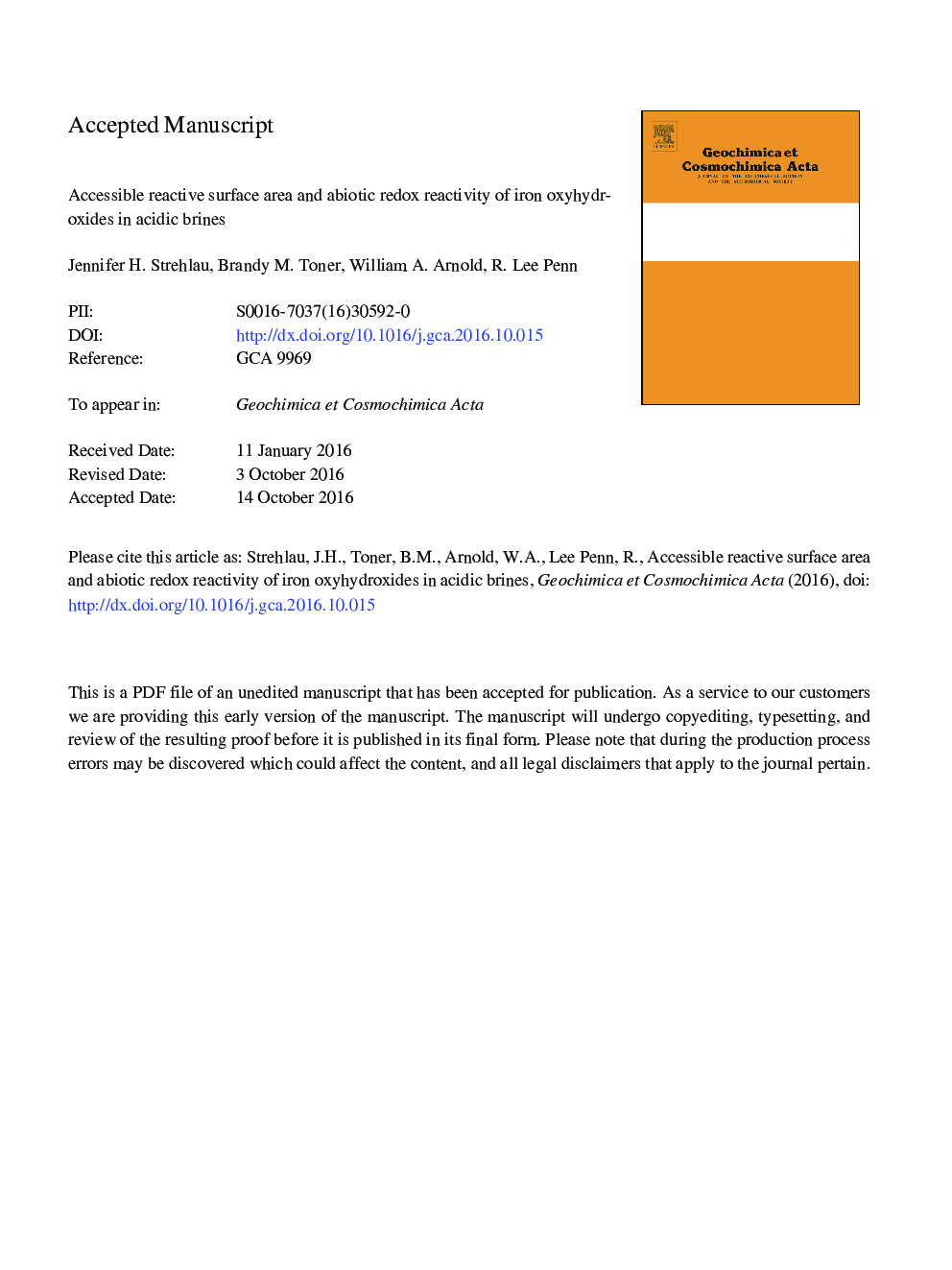| کد مقاله | کد نشریه | سال انتشار | مقاله انگلیسی | نسخه تمام متن |
|---|---|---|---|---|
| 8911060 | 1637960 | 2017 | 31 صفحه PDF | دانلود رایگان |
عنوان انگلیسی مقاله ISI
Accessible reactive surface area and abiotic redox reactivity of iron oxyhydroxides in acidic brines
ترجمه فارسی عنوان
واکنش پذیری قابل دسترس واکنش پذیری آبیوتیک اکسید هیدروکسید آهن در آب نمک اسیدی
دانلود مقاله + سفارش ترجمه
دانلود مقاله ISI انگلیسی
رایگان برای ایرانیان
موضوعات مرتبط
مهندسی و علوم پایه
علوم زمین و سیارات
ژئوشیمی و پترولوژی
چکیده انگلیسی
The reactivity of iron oxyhydroxide nanoparticles in low pH and high ionic strength solutions was quantified to assess abiotic contributions to oxidation-reduction chemistry in acidic brine environments, such as mine groundwater seepage, lakes in Western Australia, and acid mine drainage settings, which are of global interest for their environmental impacts and unique geomicrobiology. Factors expected to influence accessible and reactive surface area, including Fe(II) adsorption and aggregate size, were measured as a function of pH and CaCl2 concentration and related to the kinetics of redox reactions in aqueous suspensions of synthetic goethite (α-FeOOH), akaganeite (β-FeOOH), and ferrihydrite (Fe10O14(OH)2) nanoparticles. Aqueous conditions and iron oxyhydroxides were chosen based on characterization of natural iron-rich mine microbial mats located in Soudan Underground Mine State Park, Minnesota, USA. Quinone species were used as redox sensors because they are well-defined probes and are present in natural organic matter. Fe(II) adsorption to the iron oxyhydroxide mineral surfaces from aqueous solution was measurable only at pH values above 4 and either decreased or was not affected by CaCl2 concentration. Concentrations at or above 0.020 M CaCl2 in acetate buffer (pH 4.5) induced particle aggregation. Assessment of Fe(II) adsorption and particle aggregation in acidic brine suggested that accessible reactive surface area may be limited in acidic brines. This was supported by observations of decreasing benzoquinone reduction rate by adsorbed Fe(II) at high CaCl2 concentration. In contrast, the hydroquinone oxidation rate increased at high CaCl2 concentrations, which may be due to suppressed adsorption of Fe(II) generated by the reaction. Results suggest that iron geochemical cycling in acidic brine environments will be substantially different than for iron oxyhydroxides in low-saline waters with circumneutral pH. These findings have implications for acidic brine lakes and acid mine drainage locations that contain precipitated iron oxyhydroxides.
ناشر
Database: Elsevier - ScienceDirect (ساینس دایرکت)
Journal: Geochimica et Cosmochimica Acta - Volume 197, 15 January 2017, Pages 345-355
Journal: Geochimica et Cosmochimica Acta - Volume 197, 15 January 2017, Pages 345-355
نویسندگان
Jennifer H. Strehlau, Brandy M. Toner, William A. Arnold, R. Lee Penn,
